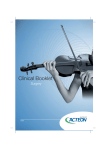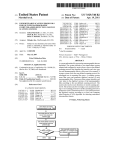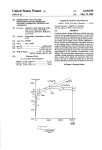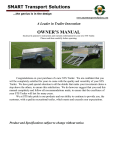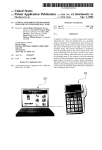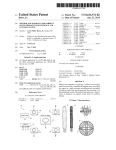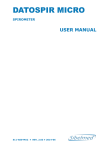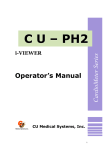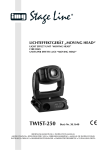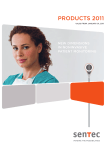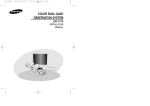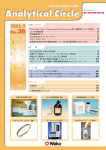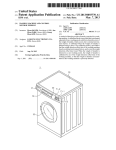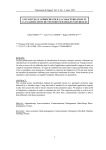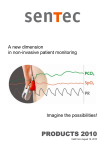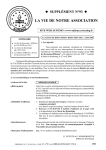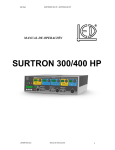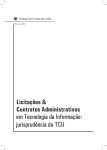Download Device and Method for Determining a Comparison Value of Biodata
Transcript
US 20090240119A1 (19) United States (12) Patent Application Publication (10) Pub. N0.: US 2009/0240119 A1 Schwaibold et al. (43) Pub. Date: (54) DEVICE AND METHOD FOR DETERMINING (30) Sep. 24, 2009 Foreign Application Priority Data A COMPARISON VALUE OF BIODATA AND FOR RECORDING BIODATA (76) Inventors: Apr. 7, 2006 Apr. 7, 2006 Matthias Schwaibold, Karlsruhe Publication Classi?cation (DE); Dirk Sommermeyer, Karlsruhe (DE); Bernd Schiiller, (51) Int_ CL A61B 5/00 Karlswhe (DE) (52) Correspondence Address: FRIEDRICH KUEFFNER 317 MADISON AVENUE, SUITE 910 NEW YORK, NY 10017 (US) (DE) .................... .. 10 2006 018 040.2 (DE) .................... .. 10 2006 018 041.0 (57) (2006.01) us. Cl. ...................................................... .. 600/301 ABSTRACT The method and the device are used for evaluating recorded measurement data. In particular, the use of the method and of the device makes it possible to detect the individual risk of a living being in respect of certain disease states and, if appro priate, to automatically evaluate correspondingly recognized (21) Appl. No.: (22) PCT Filed: 12/225,980 Apr. 4, 2007 risks in a device control. Measurement data in respect of heart-speci?c and/ or circulation-speci?c parameters or respi ration- speci?c parameters of a patient are preferably recorded and evaluated. The measurement data are determined over a de?ned period of time and the measurement data are evalu (86) PCT No.: § 371 (0X1)’ (2), (4) Date: PCT/DE2007/000614 ated taking into account the time information. A particularly Jun. 1, 2009 effective implementation of the method can be based on pat tern recognition in Which individual patterns and/or sequence patterns are evaluated. 14 Patent Application Publication Sep. 24, 2009 Sheet 1 0f 10 US 2009/0240119 A1 Fig. 1 Patent Application Publication Sep. 24, 2009 Sheet 2 0f 10 US 2009/0240119 Al N .9 1.1. Patent Application Publication Sep. 24, 2009 Sheet 3 0f 10 US 2009/0240119 Al on .@ Ll 46 41 36 Patent Application Publication Sep. 24, 2009 Sheet 4 0f 10 US 2009/0240119 A1 2'1 u.. Patent Application Publication Sep. 24, 2009 Sheet 5 0f 10 US 2009/0240119 A1 Fig. 5 Patent Application Publication Sep. 24, 2009 Sheet 6 0f 10 US 2009/0240119 Al Patent Application Publication Sep. 24, 2009 Sheet 7 0f 10 US 2009/0240119 A1 .E N 5% Patent Application Publication Sep. 24, 2009 Sheet 8 0f 10 US 2009/0240119 A1 Fig. 8 51 S2 49 50 Patent Application Publication Sep. 24, 2009 Sheet 9 0f 10 US 2009/0240119 A1 Fig. 9 Sep. 24, 2009 US 2009/0240119 A1 DEVICE AND METHOD FOR DETERMINING A COMPARISON VALUE OF BIODATA AND FOR RECORDING BIODATA [0006] Various measuring methods for determining indi vidual parameters related to the autonomic regulation of the cardiovascular system are already knoWn. Measuring meth ods of this type are described, for example, in Us. Pat. No. 5,862,805, WO 91/11956, US 2002-0029000, WO determining a reference value of biophysical data (body parameters) of an individual for determining individual risk, 02/067776, and EP 0 995 592. HoWever, so far no methods and devices have been disclosed Which relate to a compre hensive evaluation of individual measured values for the com Which system consists of at least one sensor for the noninva sive measurement of at least tWo signals, Which are selected nation of an individual risk index. [0001] The device and the method pertain to a system for prehensive consideration of individual factors in the determi from the folloWing group: CWF (continuous Wave ?uctua [0007] tion), SpO2, heart rate, and PTT (pulse transit time), and an makes it possible, on the basis of the parameters it measures, to make predictions about the individual risk that the patient’s evaluation unit connected to the sensor, Wherein the evalua tion unit has at least one analyZer, Which determines signal ranges that can be de?ned by signal analysis. [0002] Preferably, a plethysmogram is used, Which is recorded, for example, With a pulse oximeter. Various CWP’s (continuous Wave parameters) are extracted from the plethys In particular, no device presently exists Which present disease, Which is possibly but not necessarily diag nosed With the same device, might lead to the development of secondary diseases that adversely affect quality of life or life expectancy. mogram. CWP’s are various ?uctuating parameters that each describe a characteristic of the plethysmogram. For example, [0008] Similarly, no device presently exists Which makes it possible, on the basis of combinations of the parameters it measures, to provide information about Whether existing the folloWing quantities canbe computed as CWP’s: the pulse therapeutic measures and therapeutic dosages for the disease, Wave amplitude, the integral over certain intervals of the plethysmogram, the ratio of different integrals over different Which is possibly but not necessarily diagnosed With the same device, are qualitatively and/ or quantitatively suitable. intervals of the plethysmogram, a portion of the plethysmo gram that is correlated With respiration, the angle of rise of each pulse Wave, the angle of fall of each pulse Wave, the ratio of the angle of rise to the angle of fall, the duration of a pulse [0009] The device and method of the invention also concern a modular system for determining biophysical data of an Wave rise, the duration of a pulse Wave fall, the ratio of the duration of rise to the duration of fall, the pulse Wave maxi mum, the pulse Wave minimum, and a quantity related to the PTT (pulse transit time). In accordance With the invention, individual, Which consists of at least one sensor device for the noninvasive measurement of at least tWo signals. [0010] This is intended for determining, for example, sleep-related disorders and/or cardiovascular diseases and/or metabolic diseases, and for aiding in the making of a diagno sis. At present, a determination of sleep-related disturbances or disorders is alWays made by a specialiZed physician and any parameter that describes a characteristic of a segment of the plethysmogram may be represented as a CWP. usually overnight in a sleep laboratory. A polysomnograph is [0003] If CWP’s are considered as a function of time, a usually used for this purpose. Due to the small number of CWF (continuous Wave ?uctuation) signal can be computed specialiZed physicians trained in this discipline and the small number of sleep laboratories, many patients often have to Wait long periods of time, before a diagnosis can be made, if from it, Which is subject to ?uctuations that are relevant for the signal analysis. The CWF signal thus contains informa tion about the ?uctuations of the plethysmogram or of the CWP’s derived from it. It is possible to represent one of the indeed a diagnosis is ever made. folloWing quantities as a CWF signal: the pulse Wave ampli make available a device that alloWs a diagnosis to be made [0011] Therefore, one of the objectives of the invention is to tudes, parameters related to the integral over an interval of the quickly, easily and inexpensively. In addition, expanded plethysmogram, ratios of different integrals over different information, compared to the previously used polysomnog intervals of the plethysmogram, portions of the plethysmo raphy, is to be made available by evaluating parameters of the gram that are correlated With respiration, angles of rise of the pulse Wave. This expanded information should relate espe cially to the activity and evaluation of the autonomic nervous pulse Waves, angles of fall of the pulse Waves, ratios of angles of rise to angles of fall, durations of pulse Wave rises, dura tions of pulse Wave falls, ratios of the durations of rises to the durations of falls, the envelope of the pulse Wave maxima or pulse Wave minima, quantities related to the PTT (pulse tran sit time), the median line of the plethysmo gram, and the pulse rate. HoWever, it is also possible to use the PTT or other signals that are subject to ?uctuations to determine a CWF. In accordance With the invention, any ?uctuation of the plethys mogram, every CWP and every combination of different CWP’s may be represented as CWF signals. [0004] A problem that exists is that of determining a risk index, Which assists With the diagnosis, stabiliZation, and monitoring of individuals and can be determined by hospital tests and ambulatory tests. [0005] system. [0012] In particular, there are no devices at all With feWer input channels than polysomnographs Which alloW the estab lishment of a diagnosis that is comparable to that of a poly somnograph or is superior With respect to speci?c questions. [0013] Therefore, another objective of the invention is to design a device and a method of the aforementioned type in such a Way that individual applicability to a patient can be realiZed. [0014] In accordance With the invention, these objectives are achieved by the features of claim 1 and by the steps of the method speci?ed in claim 5. [0015] In this connection, at least one sensor for the non invasive measurement of at least tWo signals, Which are In many diseases, there are dependent relationships selected from the folloWing group: CWF (continuous Wave on or interactions With cardiovascular diseases, Which can ?uctuation), SpO2, heart rate, and PTT (pulse transit time), is affect the quality of life of the patient. In the past, it has been possible to determine these kinds of phenomena only statis one analyZer, the analyZer determines signal ranges that can tically for a group of patients and not for a speci?c patient. be de?ned by signal analysis, a comparator analyZes the connected to an evaluation unit, the evaluation unit has at least Sep. 24, 2009 US 2009/0240119 A1 signal ranges, taking additional parameters into account, and [0031] A plethysmogram is preferably recorded, for the result of the analysis is transmitted as an index value to a example, With a pulse oximeter and/or a multiple Wavelength pulse spectrometer (according to DE 10 2005 020022 Al, DE 102 13 692 A1 and DE 103 21 338 A1). The terms pulse oximeter and pulse spectrometer are used synonymously here. The pulse oximeter and/or pulse spectrometer use at connected output device. [0016] The goal of the invention is thus neither the diagno sis of a disease nor the pure determination of the frequency and severity of the occurrence of certain pathophysiological events. The goal rather is to use the detected signals to deter mine the tested person’s individual level of risk for suffering secondary diseases that adversely affect quality of life or life expectancy. Likewise, the form of therapy and the therapeutic dosage that are optimum for the person can be derived from the determined risk. In addition, the success of a therapy that is already in use can be measured. least tWo Wavelengths selected from the range of 400 to 2500 nm to determine at least the folloWing parameters: pulse rate, plethysmogram and oxygen saturation (SpO2 and/ or SaO2). Therefore, in the discussion Which folloWs, the terms SpO2 and SaO2 are used synonymously. [0032] At least one CWP (continuous Wave parameter) and preferably at least tWo CWP’s are extracted from the plethys [0017] By evaluating at least tWo signals selected from the folloWing group: CWF (continuous Wave ?uctuation), SpO2, heart rate, and PTT (pulse transit time), for example, by the mogram. use of photoplethysmography, it is possible to determine the Wave and to use them for the evaluation. interactions of a plurality of physiological and pathophysi ological processes. In addition, it is possible that With the use [0034] For example, it is possible to undertake a differen tiation of obstructive and central respiratory disorders on the basis of patterns detected in a CWF signal derived from the of a signi?cantly reduced number of measuring sensors com [0033] In accordance With the invention, different signals can be combined to detect relevant ?uctuations in the pulse pared to the prior art, namely, only one measuring sensor, for example, in the form of a pulse oximetry sensor, information can be obtained that is comparable to that provided by prior art methods, for example, in regard to respiratory disorders, plethysmogram. In this regard, the characteristic patterns sleep disorders, diabetes, in?ammatory reactions, vascular time is assisted if the sensor is connected to a ?rst memory conditions and cardiovascular diseases. [0018] It is thus possible to obtain individual information about a patient’s state of heath With respect to: [0019] cardiovascular risk [0020] stress [0021] [0022] diabetes in?ammatory states [0023] autonomic functional disturbances and diseases related to them [0024] risk index (percent) have frequency components that are related to the respiratory rate. [0035] Signal analysis over a predeterminable period of unit for storing a detected test signal. [0036] To carry out pattern analysis of the detected signal, it is proposed that the evaluation unit have a pattern analyZer for analyZing the behavior of the signal With respect to time. [0037] To further improve the evaluation possibilities, it is proposed that the comparator be provided With a second memory unit for storing the calculated index value. [0038] A typical evaluation sequence is carried out by evaluating the amplitude behavior of the test signal. [0039] It is also contemplated that the slope of the test signal be evaluated. [0025] class risk groups [0040] [0026] differentiation of the risk factors/treatment nec invention, it is proposed that the frequency of the test signal be essary yes/no [0027] A further objective of the invention is to provide a modular device that makes it possible to quickly and easily adapt modules that can be supplemented as needed. [0028] LikeWise, there are no devices at all that can be In accordance With another embodiment of the evaluated. [0041] With respect to the predictive sensitivity, it has been found to be especially advantageous for the intensity of change of the test signal to be evaluated. [0042] Comprehensive signal analysis can be accom adapted according to need, but rather the polysomnographs plished by carrying out pattern recognition. that are presently in use are equipped With all channels, even When only a feW channels Would be su?icient and useful for [0043] Additional signal analysis can be accomplished by carrying out periodic and/ or transient signal analysis. the current investigation. [0044] Supplementary signal analysis can be accomplished by carrying out a frequency analysis. [0045] An alternative signal analysis can be accomplished by carrying out an analysis of the slope. [0046] A signal analysis can be accomplished by forming [0029] Therefore, another objective of the present inven tion is to design a device of the aforementioned type in such a Way that it is possible to realiZe individual applicability to a patient in the sense that for an individual patient, only the speci?c modules that are actually necessary are used for the analysis. To carry out more extensive analyses, additional modules can be quickly and easily adapted to the basic mod ule. A special advantage of the device of the invention is that even medical laymen but certainly at least medical personnel histograms and/or distributions and/ or derivatives. [0047] An alternative signal analysis can be accomplished by comparing and/ or correlating threshold values. [0048] Signal analysis can be further assisted by plotting a hierarchy of signals and/ or a decision tree. or physicians With no special training in this ?eld are imme [0049] diately able to apply the device of the invention to the patient evaluation of a CWF (continuous Wave ?uctuation) signal. One possibility for signal acquisition consists in the quickly and correctly. [0050] [0030] In accordance With the invention, this objective is gram 49 are used to determine a CWF signal. In this case, the achieved by virtue of the fact that a basic module has inter faces for adapting individual supplementary modules for determining additional biophysical data, such as EKG, heart CWF 50 represents the amplitude levels of the individual pulse Waves of the plethysmogram 49. [0051] HoWever, it is also possible to use the PTT or other rate, respiratory ?oW, and PTT (pulse transit time). signals that are subject to ?uctuations to determine a CWF. For example, the amplitudes 51 of the plethysmo Sep. 24, 2009 US 2009/0240119 A1 [0052] In accordance With the invention, different signals can be combined to detect relevant ?uctuations of the pulse [0075] To suppress problems, it is helpful to carry out arti fact detection and elimination before the evaluation of the the evaluation of an oxygen saturation signal. determined parameters. [0076] Detection of short-term signal changes is assisted by evaluating a maximum value of the test signal detected by the [0054] Another possibility for signal acquisition consists in sensor that appears Within a predetermined interval of time. the evaluation of a pulse rate or heart rate signal. [0055] Another possibility for signal acquisition consists in [0077] A measuring method that is simple to apply consists in carrying out the signal acquisition With the use of photop the evaluation of a PTT (pulse transit time). lethysmography. [0056] A supplementary possibility for signal acquisition [0078] An increase in the sensitivity of the system can be realiZed by carrying out the signal analysis Within at least one Wave and to use for the evaluation. [0053] Another possibility for signal acquisition consists in consists in the evaluation of an EEG signal. [0057] It is likeWise contemplated that an EKG signal be evaluated. [0058] It is likeWise contemplated that an EMG signal be evaluated. [0059] Another measurement variant consists in the evalu ation of the oxygen saturation of the blood. [0060] Another measurement variant consists in the evalu ation of the hemoglobin concentration of the blood. [0061] To determine respiratory parameters, it is proposed predeterminable frequency band. [0079] To take interactions into consideration, it is pro posed that at least one other body parameter is evaluation by the evaluation unit. [0080] For example, it is possible to evaluate the age of the individual as an additional body parameter. [0081] It is also possible to evaluate the sex of the indi vidual as an additional body parameter. [0082] Alternatively or additionally, it is also possible to that a respiratory pattern be evaluated. evaluate the Weight of the individual as an additional body [0062] To determine other parameters, it is proposed that supplementary evaluations of the folloWing can be per parameter. Alternatively or additionally, it is also possible to evaluate one or more risk factors that are already knoWn, for formed: snoring, arousal, blood pressure, CO2, sleep stages, skin conductance, depth of sleep, sleep fragmentation, activ body parameters. ity of the parasympathetic nervous system, absolutely or in relation to the sympathetic nervous system, and vascular evaluate one or more factors that are already knoWn Which compliance. affect the autonomic regulation, especially medication, as [0063] additional body parameters. A measurement principle that is simple to realiZe example, risk factors for cardiovascular disease, as additional [0083] Alternatively or additionally, it is also possible to consists in the evaluation of optical density of at least one [0084] body region. evaluate one or more additionally determined parameters, [0064] In accordance With a typical evaluation method, it is provided that a signal analysis is carried out With respect to eters. presently existing periodic signal components. Alternatively or additionally, it is also possible to e.g., arterial oxygen saturation, as additional body param [0065] An evaluation of especially predictive signal pat [0085] Past events can be taken into consideration by evalu ating the medical history of the individual as an additional terns is realiZed by carrying out an analysis With respect to a body parameter. maximum signal change. [0086] A further increase in the quality of prediction can be realiZed by evaluating the medication of the individual. [0087] A further increase in the quality of prediction can be realiZed by evaluating reference values of other persons as additional parameters. [0088] In accordance With the invention, at least the folloW ing signals are determined, for example, With a pulse oxime [0066] Inparticular, it has been found to be advantageous to assign the index of a cumulative autonomic resting intensity to the regulation of the cardiovascular system. [0067] The detection of especially predictive events is accomplished by carrying out a signal analysis With respect to a period of activation of the autonomic nervous system [0068] A further increase in the quality of prediction can be achieved if, in the evaluation of periods of activation of the ter sensor: continuous Wave ?uctuation: CWF, SpO2, pulse rate. autonomic nervous system, at least one other parameter is [0089] evaluated. The increase in the quality of prediction can be and analyZe respiratory signals, such as How, pressure or snoring, heart rate, and PTT (pulse transit time). The use of EKG signals, EEG signals and EMG signals for the evalua tion is likeWise contemplated. In addition, blood pressure and achieved by comparing the change of various detectedparam eters or parameters derived from the detected parameters at the time of an activation of the autonomic nervous system in intensity, type and sequence With respect to time. [0069] To eliminate disturbances or singular events, it is proposed that in the determination of the index, the cumula tive number and the intensity of activation periods of the autonomic nervous system be taken into consideration. [0070] It is conducive to a simple measurement setup if the sensor determines the heart rate. [0071] Inparticular, it is contemplated that the sensor deter mines the variability of the heart rate. [0072] It is also possible for the sensor to determine the CO2 concentration can be recorded and used for the evalua tion. [0090] At least one of the folloWing methods is used to evaluate the signals: [0091] [0092] [0093] [0094] [0095] It is also possible for the sensor to determine a CWF. [0074] Alternatively, it is possible for the sensor to deter mine the pulse amplitude. pattern recognition signal analysis (harmonic/transient) frequency analysis slope analysis histograms, distributions, derivatives, integra tions [0096] PTT. [0073] In addition, suitable sensors can be added to record combination of (statistically) different factors, measured values, determined values [0097] event data, long-term trend [0098] threshold value comparison Sep. 24, 2009 US 2009/0240119 A1 [0099] correlation [0100] hierarchy of signals [0101] decision tree [0102] digital ?ltering [0103] Wavelet analysis [0104] temporary storage of signal segments, CWP seg ments or CWF segments [0105] entropy, standard deviation [0106] methods of chaos theory [0107] The result produced by the device of the invention is a risk index speci?c to the patient. This index can be expressed, for example, as a percentage. For this purpose, the namely, CWF, oxygen saturation of the blood, and pulse rate. The signals are analyZed by pattern recognition and com pared With stored values. In particular, the change of the amplitude of the pulse Wave is analyZed. The result of the comparison yields a patient-speci?c risk index that is suitable for predicting the risk of a cardiovascular disease. The device of the invention is small and portable. PoWer is supplied alternatively by batteries/rechargeable batteries and/ or a poWer cable. [0130] The measured data are stored in the device on a CompactFlash® card and transmitted to the PC online via cable or, optionally, Wirelessly. For ambulatory use, the data medical history of the patient is preferably considered along stored in the device can either be transmitted to the PC via a With the current measurement data for the determination of the risk index. At least on read-out memory in the vicinity of USB interface or read into the softWare by reading out the CompactFlash® card via a reader. the device is used as a data base. [0131] [0108] In addition, the folloWing output options are alter natively and/ or additionally provided in accordance With the analyZing biophysical data of an individual consists of a basic invention: [0109] indication of the cardiovascular risk/stress [0110] [0111] indication of the risk of developing diabetes indication of the risk of developing in?ammatory conditions [0112] indication of autonomic functional disturbances and diseases related to them [0113] indication of classes and/or risk groups [01 14] In accordance With the invention, a differentiation of the risk classes is also provided. On the basis of the output of the device of the invention, it is possible, for example, for a physician to initiate targeted treatment. [0115] In accordance With a preferred variant of the inven tion, ?rst the CWP is computed from at least one test signal. The CWF is then optionally determined from the original test signal, the CWP, or both the test signal and the CWP. [0116] The determined CWF can be used, for example, as part of an automated diagnostic system. HoWever, besides that, it is also possible to evaluate the CWF directly for a device control. [0117] In order to carry out more extensive analysis, the CWF can be compared With stored values or patterns or With current measured values. [0118] The invention is explained beloW With reference to practical examples. [0119] FIG. 1 shoWs several vieWs of a device for determin ing values. [0120] [0121] [0122] [0123] FIG. FIG. FIG. FIG. The device of the invention for determining and module With a poWer supply, a memory unit and at least one sensor device for the noninvasive measurement of at least one test signal that represents cardiac activity and/or respiratory activity. The sensor device can be selected, for example, from the folloWing group: EKG, sphygmomanometer cuff, pulse oximeter, impedance sensor, and Doppler sensor. [0132] The test signal that represents the cardiac activity and/or the respiratory activity is selected from the folloWing group: pulse rate, plethysmogram, oxygen saturation, respi ratory signal, and heart signal. The sensor device is connected to an analyZer for extracting at least one CWP (continuous Wave parameter) from the test signal and/or a device for determining at least one CWF (continuous Wave ?uctuation), such that the CWF (continuous Wave ?uctuation) is prefer ably determined from the CWP and/or the test signal. [0133] A classi?er compares at least one CWF datum and/ or quantities derived from it With stored data in order to identify physiological/pathophysiological events from this information. The events in question include, for example, apnea, With it being possible, in accordance With the inven tion, to distinguish betWeen central and obstructive apneas. [0134] In another embodiment, a classi?er compares at least one CWF datum and/or quantities derived from it With other test signals and/or CWP’s in order to identify physi ological/pathophysiological events from this information. [0135] At least some of the results of the analyZer and/or at least some of the results of the classi?er are output basically immediately, acoustically and/or graphically, preferably via a 2 shoWs adaptable sensors of the device. 3 shoWs peripherals of the device. 4 shoWs belts for attaching the device. 5 shoWs the use of the device With adapted display. [0136] are evaluated. [0137] sensors. In accordance With the invention, to identify physi ological events, at least tWo signals that are temporally related The device of the invention can be expanded With and display device. supplementary modules for measuring other signals. To this end, the modules are preferably adapted as “plug and play” [0125] modules. Supplementary sensor devices are preferably [0124] FIG. 6 shoWs a device With a connected computer FIG. 7 shoWs a diagram of a sensor recording With a raW sensor signal and an extracted signal (CWF signal). [0126] FIG. 8 shoWs a plethysmogram and an extracted adapted for this purpose. signal (CWF signal) for representing the amplitude levels. basic module and/or in supplementary modules. [0127] FIG. 9 shoWs an arm cuff With a basic module and tWo supplementary modules mounted on it. [0128] FIG. 10 shoWs a basic diagram With a basic module other devices, especially therapeutic devices, to be con and tWo supplementary modules assigned to it. [0129] In a preferred embodiment of the invention, the [0138] [0139] To this end, at least one interface is installed in the The interface also alloWs data to be read out and/or trolled. [0140] At least the folloWing alternative or supplementary adaptable sensor devices are provided: EKG, EMG, EOG, EEG, pulse oximetry, blood pressure, impedance measure device makes it possible to make a fast determination of the risk index by using a pulse oximetry sensor to make essen ment, ultrasound, Doppler, CO2, respiratory ?oW, snoring, tially simultaneous determinations of at least three signals, mouth, thorax, abdomen, position sensors. Sep. 24, 2009 US 2009/0240119 A1 [0141] The sensor devices can be supplemented in the form of a module that is designed, for example, to determine res [0160] Nonmedical electrical devices: [0161] poWer supply unit (primary side) piratory parameters, such as respiratory ?oW, PTT, movement [0162] signals, and respiratory effort. [0163] Bluetooth®-USB adapter [0164] CompactFlash® card reader [0165] PC system (external accessories) [0142] The sensor devices can also be supplemented in the form of a module that is designed, for example, to determine cardiological parameters, such as EKG and heart rate. [0143] A data input device is provided for inputting patient USB-TCP/IP converter [0166] Basic Module [0167] The basic module consists of a pulse oximeter, a data, for example, age, sex and state of health. [0144] A display is provided as a means of displaying ana lytical results. Acoustic alarms are also provided. [0145] In accordance With the invention, at least the basic module is detachably mounted on the body of a patient With fastening means, such as belts. possible interface for controlling other devices, e.g., thera peutic devices, possible additional interfaces for additional, [0146] connection for additional modules, and a display for display ing computed indices, current measured values and current battery/rechargeable battery states. For relaying the deter mined data, the basic module alloWs bidirectional data exchange With other devices, for example, With APAP In another embodiment, the device for determining and analyZing biophysical data of an individual consists of at least one sensor device for the noninvasive measurement of at least tWo signals, such as a plethysmogram and CWF (con tinuous Wave ?uctuation) signals derived from it, SpO2 and pulse rate, and an analyZer connected to the sensor device for analyZing transient and/ or periodically recurring patterns of the measured signals. This is supplemented by a module for the evaluation of information that is related to the frequency or amplitude of the signals or the parameters derived from them. [0147] In a supplementary embodiment, the device for determining and analyZing biophysical data of an individual consists of a basic module With a poWer supply, a memory unit and at least one sensor device for the noninvasive mea surement of at least one test signal that represents the respi ratory activity, for example, oxygen saturation, respiratory signal or How signal, and at least one additional sensor device for the noninvasive measurement of at least one test signal that represents the cardiac activity, for example, oxygen satu ration, blood pressure, pulse rate, EKG or plethysmogram, and an analyZer connected to the sensor device for extracting at least one CWP (continuous Wave parameter) from at least one of the test signals. [0148] For example, conclusions can be draWn about apneas, hypopneas and other respiratory disturbances. By optional sensors, e.g., connection of a respiratory ?oW/snor ing sensor, a communications interface, for example, USB, or a Wireless protocol, a readable memory, a poWer supply via battery/rechargeable battery and a data bus controller as a machines. FIG. 9 shoWs hoW the basic module 53, an adapted pneumology module 54 and an adapted cardiology module 55 are positioned on a common carrier 58 on the arm 57 of a user. Bidirectional data transmission is possible via the connected cable 56. Alternative application sites for the device of the invention are: the ?nger, toe, nose, ear, and forehead. [0168] The device of the invention has feWer input channels than standard polysomnographs and is thus considerably less expensive, smaller, lighter and more energy-e?icient. [0169] Sensors: [0170] Pulse oximetry sensor for recording a plethysmo gram and determining oxygen saturation and pulse rate. [0171] The basic module can determine the folloWing val ues: [0172] pulse rate [0173] oxygen saturation (SpO2) [0174] RDI and AHI (in each case differentiated as obstructive or central) [0175] [0176] risk value for obstructive respiratory tract disease risk value for central respiratory disturbance using at least one sensor device for the noninvasive measure [0177] risk value for PLM (periodic leg movement) ment of at least one test signal that represents the respiratory activity and at least one other sensor device for the noninva sive measurement of at least one test signal that represents the cardiac activity, it is possible to draW conclusions about dis eases of the cardiovascular system and/or the respiratory sys [0178] tem, for example, by pattern analysis. [0149] Additional embodiments are described beloW. [0150] Application portion, consisting of: [0151] basic module [0152] [0153] [0154] [0155] cardiology module pneumology module application parts battery/rechargeable battery, e.g., lithium ion [0156] battery [0157] medically acceptable poWer supply unit (sec ondary side) With all-purpose cable for charging the characteristic value for the recovery function of sleep [0179] autonomic (micro) arousal index [0180] sleep quality index [0181] index for respiratory events [0182] [0183] autonomic status characteristic value for current concentration ability [0184] [0185] characteristic value for high tiredness characteristic value for high sleep pressure [0186] autonomic rest [0187] index for cardiovascular risk (vascular disease, rhythmological disease, cardiac insu?iciency) [0188] leakage, therapeutic success [0189] index for the progression of a disease rechargeable battery and for transmitting the stored [0190] Pneumology Module data to a PC via a galvanically separated USB inter [0191] This module can be adapted to the data bus of the basic module to carry out additional analyses. In accordance With the invention, it is possible to realiZe the connection betWeen the basic module and the pneumology module as a face (converter box) [0158] PC Software: [0159] The softWare can be operated under the operating systems WindoWs 2000, SP 2 and higher, WindoWs XP Pro fessional and Home Edition. plug connection, Which can be handled quickly and easily. The pneumology module can also be used by itself, Without Sep. 24, 2009 US 2009/0240119 Al the basic module. The pneumology module has at least one effort sensor system and one sensor device for determining a respiratory ?ow signal. [0192] [0193] Possible Sensors effort sensors: (thoracic and abdominal movements); [0194] respiratory ?ow/snoring sensor (thermistors and microphone); [0195] respiratory ?ow/ snoring eyeglasses (pressure sensor); [0196] oral thermistor for determining mouth breathing in therapeutic monitoring; [0197] pneumo-T-adapter for determining respiratory ?ow, snoring, and xPAP pressure (differential pressure sensor). [0198] In conjunction with the basis module, the pneumol ogy module can determine the following values: same time, the device of the invention is charged by the power supply unit or is permanently supplied with current. [0225] PC Software [0226] biophysical signals. This assists with the establishment of a diagnosis, therapeutic stabiliZation and therapeutic monitor ing of sleep disturbances. [0227] Device Software [0228] The device software serves to detect, store, process and evaluate biophysical signals. This assists with the estab lishment of a diagnosis, therapeutic stabiliZation and thera peutic monitoring of sleep disturbances. The device software communicates with the PC software via a secure data trans mission protocol. [0229] [0199] RDI/AHI (apnea/hypopnea differentiation) [0230] [0200] [0201] [0231] arousals that are related to a respiratory event differentiation of RERAs and arousals that are related to apnea/hypopnea events [0202] differentiation of obstructive and central events [0203] ?attening [0204] snoring [0205] upper airway resistance syndrome [0206] respiratory effort, work of breathing [0207] Cardiology Module [0208] The cardiology module makes it possible to record an EKG. A position sensor can be adapted to supplement it. This module can be adapted to the data bus of the basic module for carrying out additional analyses. In accordance with the invention, it is proposed that the connection between the basic module and/ or pneumology module and cardiology The PC software serves to detect, store, process, visualiZe, evaluate, document, and archive patient-speci?c Nonmedical Electrical Devices reader for reading out the data stored on the Com pactFlash® card; online module for wireless data transmission (Bluetooth-USB adapter); [0232] USB-TCP/IP converter; [0233] PC system (external accessories). [0234] The device of the invention generates information signals (e.g., rechargeable battery charge status), which are graphically visualiZed and stored by the display and/or the PC system. These information signals serve to check for the presence of signals to be recorded and to check the proper functioning of the device. This makes it possible to avoid faulty recordings, and an otherwise necessary repetition of the overnight measurement is avoided. [0235] The automatic analyses (CWF, PTT, SpO2, pulse rate, PLM, snoring analysis, sleep stage analysis, arousal module be realiZed as a plug connection, which can be analysis, and cardiorespiratory analysis) can be carried out handled quickly and easily. The cardiology module can also be used alone, without the basic module and/or pneumology online in the device and/ or of?ine from the signals stored in the PC and assist the evaluator in diagnosing sleep distur module. bances and in initiating and monitoring therapy. [0209] The cardiology module can determine the following [0236] The PC software is used for the visualiZation, evalu values: ation, documentation and patient-speci?c archiving of long [021 0] EKG [0211] heart rate variability [0212] pulse transit time (PTT) [0213] position-dependent events terrn studies on the diagnostics of, for example, sleep distur bances, cardiovascular diseases, and diabetes. The system is con?gured for this, and the transmitted data is automatically analyZed of?ine. The software allows the input of comments by the user. Manual reclassi?cation of the analytical results by the evaluator is possible. [0237] After receiving directions from technical personnel and reading the patient instructions for use, the patient is able [0214] In accordance with the invention, it is proposed that other modules be adapted as needed. [0215] Individual device components are described in detail below. [0216] electrodes for the electrophysiological channels; [0217] effort sensors (thoracic and abdominal move ments); [0218] pulse oximetry sensor for determining oxygen saturation, pulse rate, pulse wave, CWF and PTT; [0219] respiratory ?ow/snoring sensor (thermistors and microphone); [0220] respiratory ?ow/ snoring eyeglasses (pressure sensor); [0221] oral thermistor for determining mouth breathing in therapeutic monitoring; [0222] pneumo-T-adapter for determining respiratory ?ow, snoring and xPAP pressure (pressure sensor). [0223] [0224] Converter Box and Power Supply Unit The converter box is used for cable-connected data transmission of the data stored in the device. The data is transmitted via a galvanically separated USB interface. At the to apply the sensors and the device himself. [0238] In the case of online analysis in the device, there is the possibility of directly responding to the analytical results, for example, by remote control of another device. It is pos sible, in the case of anesthesia, to control, for example, drug metering devices and/or ventilation machines, in the case of operators or pilots of a wide variety of transportation means (e.g., cars, trucks, trains, airplanes, etc.) to activate alarms, autopilot systems or the like on the basis of analytical results (e.g., lack of ability to concentrate, high level of tiredness, high sleep pressure), or, in the case of sleep medicine, to operate a therapeutic device (e.g., a CPAP machine) by remote control. [0239] It is basically possible to use the device of the inven tion both in the prevention of various diseases (risk determi nation for secondary diseases) and in real-time scenarios in which a direct response is made to currently detectedpatterns. Sep. 24, 2009 US 2009/0240119 A1 [0240] The PC software is used for the visualiZation, evalu ation, documentation and patient-speci?c archiving of long term studies on the diagnostics of, for example, sleep distur bances, cardiovascular diseases, and diabetes. The system is con?gured for this, and the transmitted data is automatically analyZed of?ine. The software allows the input of comments by the user. Manual reclassi?cation of the analytical results by the evaluator is possible. [0241] After receiving directions from technical personnel and reading the patient instructions for use, the patient is able to apply the sensors and the device himself. [0242] The device of the invention processes and stores all measured signals on the integrated memory unit, e.g., Com pactFlash® card. The data are read out either via a USB cable or by reading out the CompactFlash® card with a reader. In clinical operation, the device of the invention can transmit the recorded data online, either wirelessly or by cable connec tion, to the software, where the data is additionally stored. [0243] During online monitoring with the device of the invention, networks present in hospitals can be used. If data is lost, e.g., if the patient leaves the examination room, this data [0256] On the basis of the analytical results and the dis played signals, the present results can be evaluated according to de?nable criteria. [0257] Function of the Optional Sensors [0258] Respiratory Flow/ Snoring Eyeglasses [0259] The respiratory ?ow/ snoring eyeglasses in conjunc tion with the pressure sensor integrated in the device of the invention record the respiratory ?ow and snoring. Inspiration is recorded by the negative pressure that is generated, and expiration is recorded by the positive pressure that is gener ated. Snoring produces pressure ?uctuations in the nostrils, and these ?uctuations are likewise recorded. When the patient is breathing with his mouth closed, pressure measurement responds more sensitively to small ?ow limitations than ther mal measurement. Pressure measurement is independent of the ambient temperature and, in addition, allows visual evalu ation of the ?ow contour with respect to time. During mouth breathing, the signals can be attenuated. Alternatively, there fore, the respiratory ?ow oral sensor is used at the same time. [0260] Pulse Oximetry Sensor [0261] The pulse oximetry signals (the oxygen saturation can be supplemented with the data stored on the Compact Flash® card. The device of the invention is powered by a of the blood, the pulse rate and a CWF signal) are measured replaceable battery pack, so that it is independent of the power by the pulse oximetry sensor. network. Stored measured values are not lost during a battery change. The device can also be permanently powered and operated with the data transmission cable. [0244] The device of the invention can also have an optional position sensor. The position sensor records whether and when the patient is prone, supine or lying on his side. The device can also have an optional effort sensor integrated in the [0262] The main components of the sensor are at least two light-emitting diodes and a receiver diode. [0263] Several SpO2 values are determined for each pulse wave (split pulse wave algorithm). [0264] The measured pulse rate variations correspond with suf?cient accuracy to the heart rate variations that are trig housing. Integration reduces cleaning and increases the ser gered by a sleep apnea syndrome. vice life of the sensor. [0245] A sensor test/impedance check can be initiated by a [0265] The variation of the pulse wave, especially the amplitude of the pulse wave, is determined by photoplethys push button. mography. [0246] During a sensor test/ impedance check, it can be determined by means of light-emitting diodes or an integrated display whether the electrodes and which electrodes are [0266] The device of the invention computes a quality index for each oxygen saturation value that is determined. This quality index characterizes the quality or accuracy of the applied properly or poorly. measured SpO2 value. [0267] If the signal is disturbed by movements, the number [0247] In addition, the device of the invention has a yellow light-emitting diode in the battery pack next to the battery symbol to indicate whether the rechargeable battery is pres ently charged. This information could also be indicated by a symbol on the integrated display. It is also possible to make an inquiry about the charge state via the software, since a capac ity monitoring system is integrated in the rechargeable bat tery. [0248] The stored data can be transmitted to the PC via the USB cable or via the converter box, in which a galvanic of values is small. When the signals are undisturbed, the number of values is large. Accordingly, a disturbed test signal generates a low quality value, while an undisturbed test signal results in a high quality value. The quality signal assumes values between 0 and 100%. In the evaluation of SpO2 long terrn measurements, the quality signal can be helpful, for it indicates artifacts that occurred during the measurement. separation is integrated. The rechargeable battery can also be [0268] FIG. 1 shows a mobile unit with a pressure connec tion 1 for connection with a pressure measurement hose, electrode connections 2, an RIB 3, and a connection 4 for an charged via the converter box with the power supply unit that is also provided. A battery pack can also be charged when it is abdomen sensor 35 (not shown). The drawing also shows LED’s 5, which will be explained in greater detail below, a not inserted in the device. button 6, and a battery compartment latch 7. Also shown are a connection 8 for a battery-charge cable/data transfer cable and a rechargeable battery 9. Preferably, a second pressure [0249] [0250] Function of the Software The data transmitted during the measurement are stored and visualiZed. The data read in after the measurement connection 10 is provided. The functionality of the unit is are automatically analyZed according to time and value cri teria. The software can carry out, for example, the following further enhanced by a thorax sensor 11 and a connection 12 for a pulse oximeter sensor. automatic analyses: [0251] CWF analysis [0269] An insert card with application sites is provided on [0254] arousal analysis the back of the mobile unit. FIG. 1 also shows a Z-electrode 14 and a connection 15. The connection 15 is used for con necting to a respiratory ?ow/snoring sensor 16 or a respira tory ?ow oral sensor 27, which are shown in FIG. 2. The [0255] sleep stage analysis connection 1 is provided for connection with respiratory [0252] snoring analysis [0253] cardiorespiratory analysis Sep. 24, 2009 US 2009/0240119 A1 ?oW/snoring eyeglasses 22 or a pressure measurement hose [0278] 28. The connections 1, 10 are used together for connecting and/or additionally, make it possible to determine the concen With a pneumo-T-adapter 33. [0270] In addition to the sensors for connection to the tration of hemoglobin (cHb), oxyhemoglobin (HbO2), mobile unit that have already been mentioned, FIG. 2 shoWs sensor beads 17, a sleeve 18, a microphone 19, a mounting plate 20, and a sensor plug 21. The draWings also shoW a sleeve 23, canulas 24, a clip 25, and a connection 26 for the respiratory ?oW/ snoring eyeglasses 22. [0271] The pressure measurement hose 28 comprises a connecting piece 29, a connecting hose 30, a plastic hose 32, and a thread 31 for a CPAP connection. Other sensors shoWn in the draWings are a pulse oximetry sensor 34 and an abdo men sensor 35. [0272] FIG. 3 shoWs components for the data transfer: The mobile unit is typically connected to an evaluation unit, Which can be realiZed as a personal computer. In this regard, the evaluation unit comprises a CD-ROM drive With CD 36, a charger 37 With a poWer supply unit 38 and plug 39, a charge/ data transfer cable 40, and a USB cable 41 . A converterbox 42 is equipped With a jack 43 for the charge/data transfer cable 40, a USB jack 44, and a charger jack 45. Data transmission from the mobile unit to the evaluation unit can also be effected directly by removing the memory card 46 from the mobile unit and inserting it into the evaluation unit. [0273] FIG. 4 shoWs a device belt 47 and an abdominal belt 48 for assisting mobile use. The belts are used to fasten the device of the invention on a user. The belt is closed With a buckle. The belt can be adjusted to the girth of the body by adjusting the hook tapes. The belt consists of an elastic loop tape that is nonirritating to the skin. [0274] The left side of FIG. 5 shoWs the use of the device of the invention With a respiratory ?oW/snoring sensor 16, and the right side shoWs its use for pressure measurement in a ventilator mask. The device is fastened on the user and is connected to a pulse oximetry sensor and a respiratory ?oW/ snoring sensor (left) or is connected to a ventilator hose With a pneumo-T-adapter (right). [0275] FIG. 6 shoWs a device connected to an evaluation unit, Which is realiZed here as a personal computer. Data is transmitted to a PC via a medically acceptable poWer supply unit With an all-purpose cable for charging the rechargeable battery and for transmitting the stored data via a galvanically separated USB interface of the converter box. The converter box is used for cable-connected data transmission of the data stored in the device. The data is transmitted galvanically separately via a USB interface. At the same time, the device of the invention is charged via the poWer supply unit or perma nently supplied With current. The PC softWare runs on the PC. The PC softWare serves to detect, store, process, visualiZe, evaluate, document, and archive patient-speci?c biophysical signals. This assists With the establishment of a diagnosis, therapeutic stabiliZation and therapeutic monitoring of sleep disturbances. [0276] The pulse oximetry sensor 34 measures the pulse oximetry signals (the oxygen saturation of the blood and the pulse rate of the patient). The main components of the sensor Optionally, sensors are used, Which, alternatively deoxyhemoglobin (HbDe), carboxyhemoglobin (HbCO), methemoglobin (MetHb), sul?nethemoglobin (HbSulf), bilirubin, and glucose. To this end, the sensors have at least one light source, Which alternatively and/or supplementally emits Wavelengths selected from the folloWing group of Wavelength ranges: 150 nm:15%, 400 nm:15%, 460 nm:15%, 480 nm:15%, 520 nm:15%, 550 nm:15%, 560 nm:15%, 606 nm:15%, 617 nm:15%, 620 nm:15%, 630 nm:15%, 650 nm:15%, 660 nm:15%, 705 nm:15%, 710 nm:15%, 720 nm:15%, 805 nm:15%, 810 nm:15%, 880 nm:15%, 890:15%, 905 nm:15%, 910 nm:15%, 950 nm:15%, 980 nm:15%, 980 nm:15%, 1000 nm:15%, 1030 nm:15%, 1050 nm:15%, 1100 nm:15%, 1200 nm:15%, 1310 nm:15%, 1380 nm:15%, 1450 nm:15%, 1600 nm:15%, 1650 nm:15%, 1670 nm:15%, 1730 nm:15%, 1800 nm:15%, 2100 nm:15%, 2250 nm:15%, 2500 1111111 5%, 2800 1111111 5%. [0279] The device of the invention computes a quality index for each oxygen saturation value that is determined. This quality index characterizes the quality or accuracy of the measured SpO2 value. If the signal is disturbed by move ments, the number of values is small. When the signals are undisturbed, the number of values is large. Accordingly, a disturbed test signal generates a loW quality value, While an undisturbed test signal results in a high quality value. The quality signal assumes values betWeen 0 and 100%. In the evaluation of SpO2 long-term measurements, the quality sig nal can be helpful, for it indicates artifacts that occurred during the measurement. [0280] FIG. 7 shoWs the measured signal 49 as a raW plethysmogram. The plethysmogram 49 is subject to ?uctua tions. A CWF signal 50 is extracted from the plethysmogram 49. The CWF signal 50 contains information about the ?uc tuations of the plethysmogram. For example, the ?uctuation can represent the pulse Wave amplitude. It is also possible to represent the integral of the plethysmogram as a CWF. [0281] FIG. 8 shoWs a possible embodiment of the CWF signal. Here the amplitudes 51 of the plethysmogram 49 Were used to determine the CWF signal. In this case, the CWF 50 represents the amplitude level of the plethysmogram 49. [0282] HoWever, it is also possible to use the PTT or other signals that are subject to ?uctuations to determine a CWF. [0283] In accordance With the invention, different signals can be combined to detect relevant ?uctuations of the pulse Wave and use them for the evaluation. [0284] Thorax Sensor and Abdomen Sensor [0285] Thorax and abdomen sensors are used to detect tho racic and abdominal respiratory movements. [0286] In this regard, respiratory movements cause variable tensile stresses on the measuring pickups in the fastening belts. The measuring pickups use the pieZoelectric effect to convert the movements to electrical signals. [0287] The abdominal sensor, together With the abdominal belts, detects the abdominal respiratory movements. The sen sor is made of a plastic that is nonirritating to the skin. are at least tWo light-emitting diodes and a receiver diode. For [0288] Electrophysiological Signals example, several SpO2 values are determined for each pulse Wave (split pulse Wave algorithm). [0277] The measured pulse rate variations correspond With [0289] suf?cient accuracy to the heart rate variations that are trig gered by a sleep apnea syndrome. The electrophysiological signals are measured by electrodes. Gold cup electrodes or adhesive electrodes can be used for this purpose. [0290] electroencephalogram (EEG) [0291] electrooculogram (EOG) Sep. 24, 2009 US 2009/0240119 A1 [0292] electromyogram (EMG) [0293] electrocardiogram [0294] Respiratory FloW/ Snoring Sensor [0295] Nasal and oral respiratory How and snoring sounds are detected With the respiratory ?oW/ snoring sensor. The sensor beads consist of thermistors. They detect the respira tory ?oW by the temperature of the exhaled and inhaled air. The microphone records the snoring sounds of the patient. [0296] Respiratory FloW Oral Sensor 27 [0297] Oral respiratory How is detected With the respiratory ?oW oral sensor during diagnosis With the respiratory ?oW/ snoring eyeglasses, therapeutic stabilization, or therapeutic monitoring. The sensor beads consist of thermistors. They detect the respiratory ?oW by the temperature of the exhaled and inhaled air. The respiratory ?oW oral sensor 27 is used during diagnosis together With the respiratory ?oW/ snoring eyeglasses or during therapeutic stabiliZation or therapeutic monitoring for detecting mouth breathing together With the pneumo-T-adapter 28. [0298] Pneumo-T-Adapter 28 [0299] The pneumo-T-adapter is used together With a nasal mask for therapeutic monitoring. It is used for recording the respiratory How and the snoring of the patient during therapy and for measuring the therapeutic pressure applied in the mask. Inspiratory and expiratory pressure ?uctuations are conveyed from the mask to the device via the pressure mea surement hoses. The exhalation of air generates a slight posi tive pressure, and the inhalation of air a slight negative pres sure. The breaths taken by the patient can be derived from the pressure differences. Snoring sounds are measured by rapid pressure changes. The therapeutic pressure is derived from the static component of the pressure signal. The pneumo-T adapter 28 is used together With xPAP machines during thera peutic stabiliZation and therapeutic monitoring. The pneumo ured via the CompactFlash® card reader and/or several Com pactFlash® cards With different con?gurations can be installed. [0308] Optional Modules [0309] Supplementary PC softWare alloWs the therapeutic monitoring data to be read out and displayed, the remote control of all cited therapeutic apparatus via the softWare, and the PC-assisted evaluation of titration data from a ventilator titration instrument. [0310] Combination With Therapeutic Systems [0311] The device of the invention can be combined as a monitoring system With current CPAP, bilevel and APAP titration home ventilator therapeutic systems. The system can be connected quickly and easily by the pneumo-T-adapter, Which is inserted betWeen the hose and the mask. [03 12] Peripheral Devices [0313] USB port: supported by WindoWs [0314] connections: at least three free USB interfaces for connecting a card reader, a USB connecting cable to the data logger, and a Bluetooth®-USB adapter [0315] graphics card: supported by Microsoft WindoWs, minimum resolution 1024x768, 16 bit color depth [0316] monitor: 17" or larger CRT monitor or 15" or larger TFT monitor [0317] mouse: Windows-compatible mouse [0318] printer: supported by Microsoft WindoWs [0319] netWork: netWork card 10/100 Mbit (only if the netWork-USB server is used) [0320] SoftWare [0321] The softWare is used for analysis and offers altema tive evaluation proposals. The evaluation of the automatically prepared analytical results is the responsibility of the physi cian. With each neW programming of the device of the inven tion, the clock time in the basic device is synchroniZed With the system clock time of the PC. If data transmission to the PC is interrupted, the measurement data continues to be stored in the device. In the softWare, the signals are represented as the T-adapter can be used together With the respiratory ?oW oral sensor 27 to detect mouth breathing and mouth leakage. The pneumo-T-adapter has a standard tapered socket (ISO 22) for connection to therapy masks. [0300] EXG Electrodes [0301] The quantity detected With the electrodes is poten tial difference. A potential difference betWeen tWo points of the body is being measured. Since the measurement on the skin surface is made noninvasively, the measurable potential [0322] As With the EMG’s, bipolar derivations are also used for the EKG. The polysomnographic derivation of the differences are small. They are on the order of [1V in the case patient by means of belts, Which can be guided in eyes (a, b, Zero line. All data can be read out. device of the invention is based on the Einthoven derivation. The reference electrode in the device of the invention is the ground electrode on any part of the body. [0323] The device of the invention can be attached to the of EEG’s, EOG’s, and EMG’s and on the order of mV in the c) located on the sides of the device. The belts can be adjusted case of EKG’s. to the girth of the patient by hook tapes. The belt consists of an elastic loop tape that is nonirritating to the skin. [0302] Bluetooth-USB Adapter [0324] Carrying Out a Sensor Test [0303] With the Bluetooth-USB adapter, data can be Wire lessly received or transmitted online by the device of the invention, the device can be con?gured, and application [0325] To check that all of the sensors are properly con nected, a test can be performed after the sensors and devices monitoring can be carried out. have been attached. This is done by pressing the button 6. [0304] NetWork USB Server [0305] The device of the invention can be operated over a netWork With the USB server. The USB server in conjunction With the Bluetooth-USB adapter enables the device of the invention to receive data Wirelessly. In addition, the device can be con?gured, and application monitoring can be carried out. The device of the invention can also be cable-connected via the converter box. [0306] CompactFlash® Card Reader [0307] Data stored on the CompactFlash® card can be read out by the device of the invention With the CompactFlash® card reader. The device of the invention can also be con?g Operation Device Sensor test During the sensor test, the LED of the sensor noW is running Sensor test OK being tested blinks fast (4 x per second). The LED of the corresponding signal stops blinking after completion of the impedance test: impedance ofthe electrode < 5 k9 OK, or sensor signal present. Sensor testing The LED of the corresponding signal blinks slowly after completion of the impedance test: means impedance ofthe electrode < 10 k9 not optimal
























